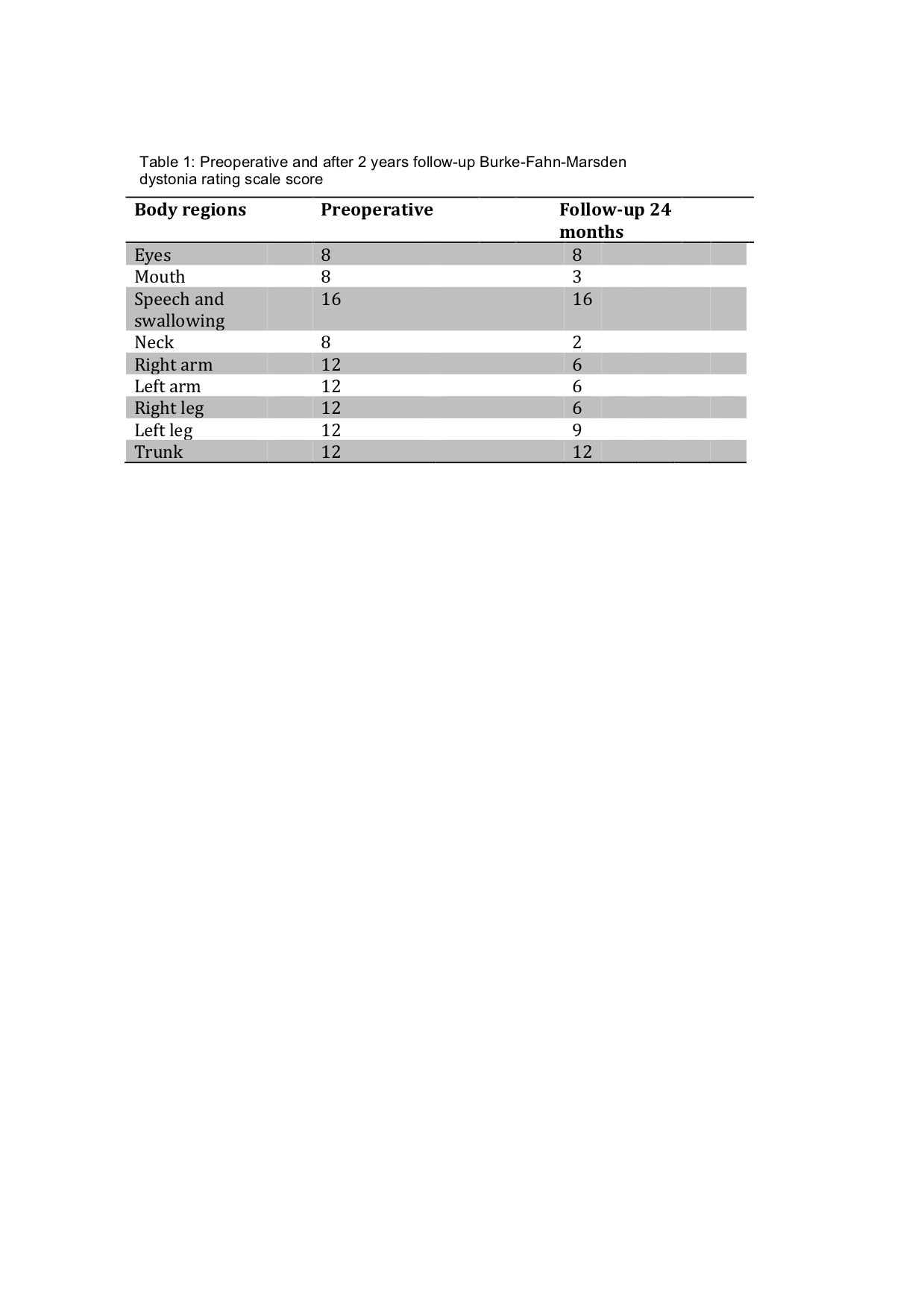Objective: We report a MTS patient genetically confirmed who presented with progressive generalized dystonia, deafness, and cognitive and behavioral abnormalities that were treated by internal globus pallidus (GPi) deep brain stimulation (DBS).
Background: Mohr-Tranebjaerg syndrome (MTS), also known as deafness-dystonia-optic neuronopathy syndrome is an X-linked recessive, neurodegenerative disorder resulting from mutations in the TIMM8A gene. MTS is characterized by sensorineural hearing loss that appear to be usual features in early childhood. This is followed by infancy onset progressive dystonia, ataxia, spasticity, cognitive impairment, psychiatric disease, and optic atrophy.
Method: A 41 year-old man presented sensory-neural deafness since 18 months old, which was followed by progressive generalized dystonia, cognitive and behavioral impairments. Despite optimal pharmacological and non-pharmacological treatment, he manifested gradual dystonia worsening in gait and upper limbs, cervical and face. Brain MRI demonstrated atrophy of the head of caudate nuclei and abnormal iron deposition in the nigra substance and globus pallidus. MTS diagnosis has been genetically confirmed by identifying hemizygosis in the gene TIMM8A. After failing use of available treatment, we decided to perform GPi DBS.
Results: After 2 years follow-up, he had a Burke-Fahn-Marsden Dystonia Rating Scale score of 24 for disability and 68 for dystonia movement (Table 1). Therefore, after the 2-year follow-up, he showed a 32% greater improvement in the cervical region and upper limbs on the dystonic movement scale.
Conclusion: Our case report shows that the patient experienced improvement of cervical and limbs dystonia, which remained stable during the 2-years outcomes. Unfortunately, we could not observe changes on patient’s gait. Another interesting aspect in our report was the presence of abnormal iron deposition in globus pallidus, similar to diseases of the spectrum of Neurodegeneration with Brain Iron Accumulation. We reported a successful implantation and management of a bilateral GPi-DBS system in MTS patient. Overall, improvements of dystonic symptoms were maintained at a 2 years-follow-up. GPi-DBS can be considered in severe disabling dystonia in MTS. Further research with a series of patients is needed to confirm these findings.
References: 1. Ha AD, Parrat KL, Rendtorff ND, Lodahl M, Ng K, Rowe DB, Sue CM, Hayes MW, Tranebjærg L, Fung VSC. The phenotypic spectrum of dystonia in Mohr-Tranebjaerg syndrome. Movement Disorders 2012; 27(8): 1034-1040.
2. Kojovic M, Pare I, et al. The Syndrome of Deafness-Dystonia: Clinical and Genetic Heterogeneity. Movement Disorders 2013; 28(6): 795-803.
3. Havránková P, Jech R, Roth J, Urgošík D, Růžička E. Beneficial effect of deep brain stimulation of GPi in a patient with dystonia-deafness phenotype. Movement Disorders 2009, 24(3): 465-466.
4. Cif L, Gonzalez V, Garcia-ptacek S, James S, Boetto J. Progressive Dystonia in Mohr-Tranebjaerg Syndrome With Cochlear Implant and Deep Brain Stimulation. Movement Disorders 2013, 28(6): 737–738..
To cite this abstract in AMA style:
L. Barcelos, M. Marinho, T. Capato, V. Borges, H. Ferraz. Bilateral Globus Pallidus Internus Deep Brain Stimulation in Progressive Dystonia in Mohr-Tranebjaerg Syndrome: Case Report and Review [abstract]. Mov Disord. 2023; 38 (suppl 1). https://www.mdsabstracts.org/abstract/bilateral-globus-pallidus-internus-deep-brain-stimulation-in-progressive-dystonia-in-mohr-tranebjaerg-syndrome-case-report-and-review/. Accessed July 15, 2025.« Back to 2023 International Congress
MDS Abstracts - https://www.mdsabstracts.org/abstract/bilateral-globus-pallidus-internus-deep-brain-stimulation-in-progressive-dystonia-in-mohr-tranebjaerg-syndrome-case-report-and-review/

